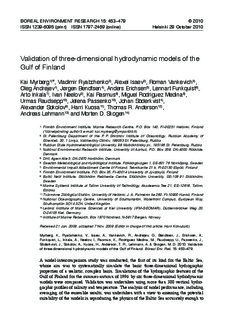| dc.contributor.author | Myrberg, Kai | |
| dc.contributor.author | Ryabchenko, Vladimir | |
| dc.contributor.author | Isaev, Alexei | |
| dc.contributor.author | Vankevich, Roman | |
| dc.contributor.author | Andrejev, Oleg | |
| dc.contributor.author | Bendtsen, Jørgen | |
| dc.contributor.author | Erichsen, Anders | |
| dc.contributor.author | Funkquist, Lennart | |
| dc.contributor.author | Inkala, Arto | |
| dc.contributor.author | Neelov, Ivan | |
| dc.contributor.author | Rasmus, Kai | |
| dc.contributor.author | Rodriguez Medina, Miguel | |
| dc.contributor.author | Raudsepp, Urmas | |
| dc.contributor.author | Passenko, Jelena | |
| dc.contributor.author | Söderkvist, Johan | |
| dc.contributor.author | Sokolov, Alexander | |
| dc.contributor.author | Kuosa, Harri | |
| dc.contributor.author | Anderson, Thomas R. | |
| dc.contributor.author | Lehmann, Andreas | |
| dc.contributor.author | Skogen, Morten D. | |
| dc.date.accessioned | 2010-11-18T13:48:36Z | |
| dc.date.available | 2010-11-18T13:48:36Z | |
| dc.date.issued | 2010-10 | |
| dc.identifier.issn | 1239-6095 | |
| dc.identifier.issn | 1797-2469 | |
| dc.identifier.uri | http://hdl.handle.net/11250/108452 | |
| dc.description | Journal homepage: http://www.borenv.net/ | en_US |
| dc.description.abstract | A model-intercomparison study was conducted, the first of its kind for the Baltic Sea, whose aim was to systematically simulate the basic three-dimensional hydrographic properties of a realistic, complex basin. Simulations of the hydrographic features of the Gulf of Finland for the summer–autumn of 1996 by six three-dimensional hydrodynamic models were compared. Validation was undertaken using more than 300 vertical hydrographic profiles of salinity and temperature. The analysis of model performance, including averaging of the ensemble results, was undertaken with a view to assessing the potential suitability of the models in reproducing the physics of the Baltic Sea accurately enough to serve as a basis for accurate simulations of biogeochemistry once ecosystem models are incorporated. The performance of the models was generally satisfactory. Nevertheless, all the models had some difficulties in correctly simulating vertical profiles of temperature and salinity, and hence mixed layer dynamics, particularly in the eastern Gulf of Finland. Results emphasized the need for high resolution in both vertical and horizontal directions in order to resolve the complex dynamics and bathymetry of the Baltic Sea. Future work needs to consider the choice of mixing and advection schemes, moving to higher resolution, high-frequency forcing, and the accurate representation of river discharges and boundary conditions. | en_US |
| dc.language.iso | eng | en_US |
| dc.publisher | Finnish Environment Institute | en_US |
| dc.subject | hydrography | en_US |
| dc.subject | hydrografi | en_US |
| dc.subject | numerical simulations | en_US |
| dc.subject | numerisk havmodellering | en_US |
| dc.subject | Baltic Sea | en_US |
| dc.subject | Østersjøen | en_US |
| dc.title | Validation of three-dimensional hydrodynamic models of the Gulf of Finland | en_US |
| dc.type | Journal article | en_US |
| dc.type | Peer reviewed | en_US |
| dc.subject.nsi | VDP::Mathematics and natural science: 400::Geosciences: 450::Hydrology: 454 | en_US |
| dc.subject.nsi | VDP::Mathematics and natural science: 400::Geosciences: 450::Oceanography: 452 | en_US |
| dc.source.pagenumber | 453-479 | en_US |
| dc.source.volume | 15 | |
| dc.source.journal | Boreal Environmental Research | |
| dc.source.issue | 5 | |
